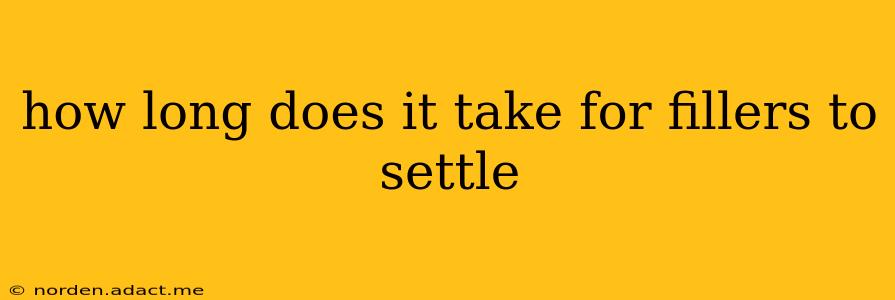Dermal fillers are a popular cosmetic procedure used to enhance facial features, reduce wrinkles, and restore volume. However, one common question patients have is: how long does it take for fillers to settle? The answer isn't a simple number of days, as it depends on several factors. This comprehensive guide explores the settling process, influencing factors, and what to expect during and after your treatment.
What Happens When Filler is Injected?
Before we delve into settling times, understanding the immediate post-injection process is crucial. Immediately after injection, the filler sits in the dermis, a layer of your skin. Your body's natural response is to begin integrating it. This includes swelling, which is a normal part of the healing process. The filler itself is a gel-like substance, and its initial placement might appear slightly uneven or unnatural.
How Long Does it Typically Take for Fillers to Settle?
While individual experiences vary, most patients notice significant settling within one to two weeks. This timeframe allows the initial swelling to subside and the filler to integrate more naturally into the surrounding tissue. However, it's essential to remember that the full settling process can take up to two to four weeks, or even longer in some cases.
Factors Affecting Filler Settling Time:
Several factors influence how long it takes for your fillers to settle. These include:
Type of Filler:
Different fillers have different compositions and densities, impacting their settling time. Thicker fillers generally take longer to settle than thinner ones. Your injector will discuss the specific filler being used and its expected settling time.
Injection Technique:
The skill and experience of the injector play a critical role. Precise injection techniques minimize swelling and bruising, leading to faster settling.
Location of Injection:
The area where the filler is injected also influences settling time. Areas with more movement, such as the lips or around the mouth, might take slightly longer to settle than areas with less movement, like the cheeks.
Individual Healing Process:
Individual healing rates differ. Some people heal faster than others, affecting the settling time of their fillers.
What to Expect During the Settling Period:
During the settling period, you may experience:
- Swelling: This is a common side effect, often peaking within the first 24-48 hours.
- Bruising: This can also occur at the injection site, usually resolving within a few days to a week.
- Tenderness: Some tenderness or slight discomfort is possible at the injection site.
What to Do if You're Concerned About Your Filler Settling:
If you're concerned about the appearance of your filler or experience unusual side effects, contact your injector immediately. They can assess the situation and provide guidance or make necessary adjustments.
Can You Speed Up the Filler Settling Process?
There is no guaranteed way to significantly speed up the natural settling process. However, following your injector's post-treatment instructions, including avoiding strenuous activity and keeping the area clean, can help promote optimal healing and reduce swelling.
How Long Do Fillers Last?
This is a frequently asked question related to filler settling. The longevity of fillers depends on the type of filler used and individual factors, typically lasting anywhere from six months to two years. This is separate from the settling period, which is the initial adjustment of the filler in your skin.
What if my filler is still uneven after several weeks?
If you feel your fillers are uneven after several weeks, you should contact your injector. This could be due to various factors, including the injection technique, the type of filler, or an unexpected reaction. They can assess the situation and determine if any adjustments are needed.
Is it normal to feel lumps or bumps after filler injections?
Minor lumps or bumps can sometimes occur following filler injections. Usually, these resolve naturally as the filler settles; however, you should always consult with your injector if you're concerned about any persistent lumps or bumps.
This guide offers a comprehensive overview of filler settling. Remember, patience is key, and consulting a qualified and experienced injector is crucial for optimal results and to address any concerns you may have.
